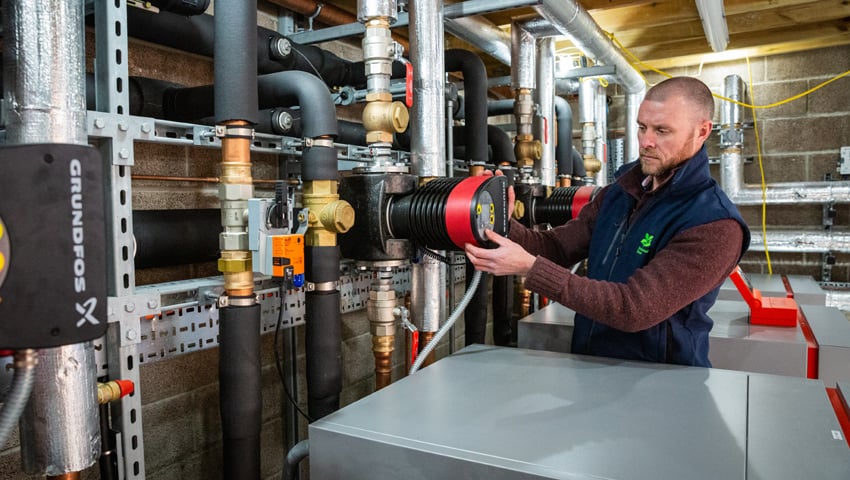One of the most opulent country houses in the south of England has replaced its unreliable and oil-hungry boilers with a pioneering ground source heat pump in a bid to tackle climate change.
The 17th-century Kingston Lacy, in Dorset, built to resemble a Venetian palace and renowned for its remarkable collection of paintings, will save 30,000 litres of oil each year by making the switch to a renewable heating system.
It is one of the National Trust’s biggest heat pump projects to date, and the first high temperature ground source system the charity has installed.
The old oil tank has been replaced by almost 6,000m of underground pipes, which transport natural ambient heat in the ground to four high temperature heat pumps, that in turn warm the mansion house and courtyard buildings. The complex installation of pipework involved drilling 32 vertical boreholes in an overflow car park, with each hole measuring a staggering 180m in depth.
Specialists spent two years conducting extensive archaeological and ecological surveys to ensure the protection of the historic parkland.
As well as saving approximately 57 tonnes of carbon a year, the new heating system will remove the danger of oil spills from the previous “high risk” boilers and storage tank.
Importantly, the heat pump will also improve conservation of the building and its collection by stabilising the temperature and humidity levels. The house includes one of the UK’s finest collections of paintings, with works by Titian, Velazquez and Rubens, and an extravagant Spanish Room that the estate’s creator, William John Bankes, designed from exile.
Owen Griffith, Lead Renewable Heating Project Manager for the National Trust, said, “Even in the most historically significant settings like Kingston Lacy, it’s possible to integrate these modern technologies while maintaining the utmost care for the building and the grounds.
“Not only will the heat pump reduce the property’s dependency on fossil fuels, but it’ll create a safer environment and improve conditions for the amazing collection items here. There are so many advantages.”
Owen continued, “Magnificent buildings like these have been around for centuries, but their heating systems have evolved – from open fires to coal boilers and then oil boilers, with many energy innovations along the way. This is simply the next step in Kingston Lacy’s history and preservation.”
Dr Elena Greer, Curator at Kingston Lacy, added, “We’re proud to house one of the National Trust’s most significant holdings of fine art, including an internationally renowned collection of Old Master paintings. The new heat pump means we can more easily maintain the optimum environmental conditions for their display, ensuring that they can be enjoyed by generations of visitors long into the future.”
In 2022, the Trust announced it had removed a million litres of oil from its properties since 2013, following a nine-year investment programme to “get off oil” and grow its own green energy supply.
Another 100 renewable projects – including many heat pumps – are in the pipeline for the next six years to further reduce fossil fuel use and help the charity reach its ambition of net zero by 2030.
Other innovative heat pump projects previously completed by the Trust include a water-source heat pump at The Vyne in Hampshire, which utilises collector pipes beneath a boating lake, and a ground-source heat pump at Speke Hall near Liverpool, that’s also home to one of the first wet central heating systems to be installed in Britain.
The Trust has also installed heat pumps in domestic buildings, including holiday and residential cottages.
Owen concluded, “Most of our visitors won’t notice the low-carbon energy systems working hard behind the scenes – and we’re proud of that. We want our renewable technologies to complement the fabric of the setting. That has been a guiding principle from the start.”
The project at Kingston Lacy has been made possible by a funding contribution from Low Carbon Dorset as part of the European Regional Development Fund.
